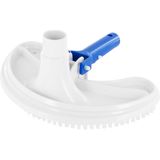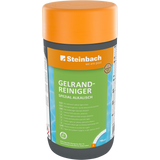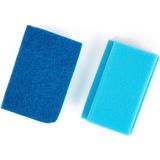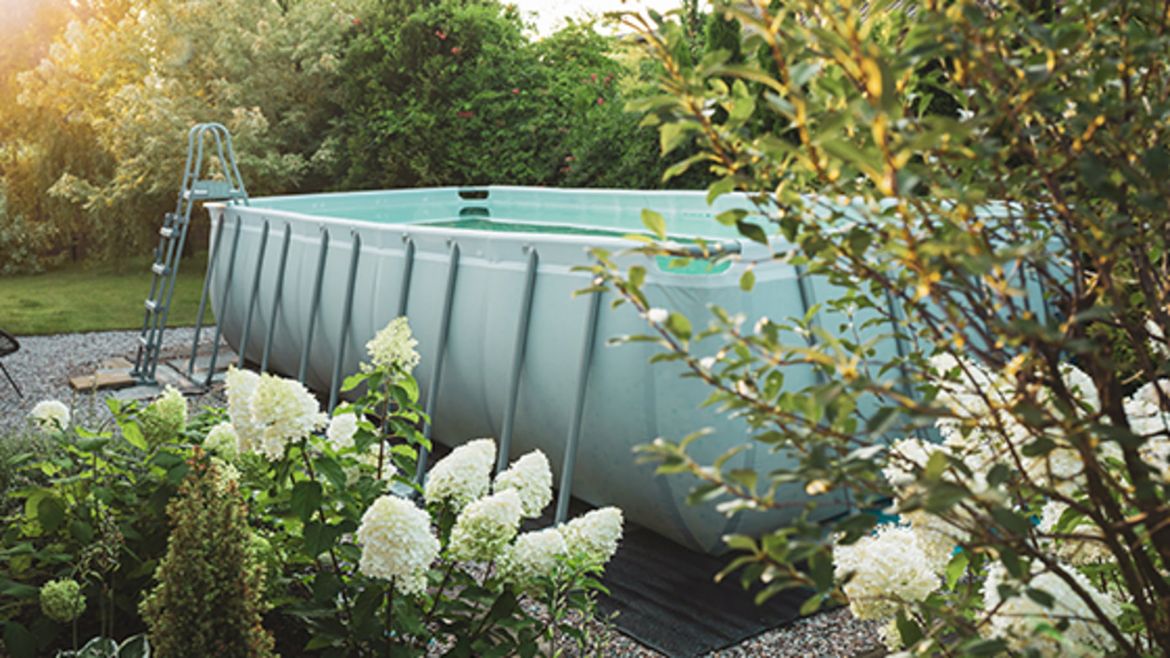Get Your Pool Ready In 7 Steps
Getting your pool ready is easy and quick - as long as you winterised it properly
If you've done a good job of winterising and generally taking good care of your pool and pool water, you can skip a lot of steps. Ideally, it's enough to remove the tarpaulin and check the water values. But let's take a look at all the steps there are to consider.
Step 1: Remove and store the winter tarpaulin
You usually use a special winter tarpaulin for winterisation. Take this off and clean and disinfect it (for example, with Domestos). Dry the cover and put it away. This prevents the tarpaulin from mouldering over the following months.
Step 2: Rough cleaning of the bottom of the pool
Dirt can get under the tarpaulin from time to time. This mostly happens when strong storms blow the cover partially or completely off the pool. Use a pool vacuum cleaner or pool robot to remove any debris.
Step 3: Check and clean the waterline
The waterline is the part of the pool around 3-10 cm above the water. If this wasn't thoroughly cleaned during winterisation, it should be cleaned now. You can lower the level of the water in the pool a little to make cleaning easier. You can use the Gel Rim Cleaner by Steinbach here.
How to get the best results when cleaning
The following tips make sure you get good results:
- Alkaline cleaners are ideal for cleaning organic dirt.
- Acid cleaners are best for dissolving limescale
- Alkaline cleaners in particular must have enough time to act. Leave them for 10-15 minutes. You might have to wait for longer to get rid of stubborn dirt - alkaline gel cleaners are a particularly good choice here.
- The warmer it is, the better the cleaning agents work.
- You need to rub to get rid of the dirt - you can exert quite some pressure. But do not use harsh brushes - scratches that result can become magnets for dirt. Microfibre cloths or even the Steinbach Hand Scrubber Set are ideal.
Step 4: Intensive cleaning
This step is extremely time-consuming. Only do this if there is a good reason - for example if you did not properly winterise your pool - or if it hasn't been given an intensive clean in several years. First, drain all the pool water. Now mix alkaline pool cleaner (acid cleaner as needed) in a ratio of 1:100 to 1:10 in a bucket of water. Apply the pool cleaner to the entire pool liner and connections if necessary. The alkaline cleaner should be left on for at least 10 minutes. This is a large area so you could apply the cleaning mixture using a pressure sprayer.
Be careful with cleaners!
- Always wear rubber gloves
- Ensure the cleaners don't come into contact with your skin or eyes
- Do not inhale the vapours of cleaners under any circumstances
- Be careful with cleaners based on hydrochloric acid: contact with steel or metal will cause severe rusting. Be particularly careful if you use acid cleaners to clean steel walled pools and frame pools! The same applies to stainless steel ladders, hose clamps, etc., - stay away from hydrochloric acid products!
- Do not mix cleaners such as chlorine bleach and hydrochloric acid: this can produce toxic chlorine gases! Always use only one cleaner at a time!
Step 5: Time for the final checks
If you do drain the water completely, take this opportunity to check the pool liner for damage. Also, check to see if all the seals look good and if any pool lighting is working.
Step 6: Add water
Now, raise the water level again. If possible, refrain from using well water or - if you do opt for well water - use Steinbach Metal Ex to reduce the amount of metals present, as they may otherwise lead to problems.
Step 7: Adjust pool water
The last step before you're ready for spring is to check the pool water and adjust it if necessary. Measure the pH level of the pool water. If it is not between 7.0 and 7.4 use an appropriate product to lower or increase the pH. Then measure the free chlorine concentration: it should be between 0.3-0.6mg per litre. Increase the concentration if it is too low. You should only shock chlorinate if your pool water doesn't seem clear or you're otherwise concerned that the water quality isn't right. If the water looks good, shock chlorination is unnecessary. Now you can jump into your pool and enjoy the spring. Have fun!
Bonus: Prepping your sand filter
Hopefully, your sand filter system is set to "winter" on the multi-port valve, which takes the strain off the internal rubbers. Depending on the age and condition of your sand filter system, you may want to consider using an alkaline cleaner on the inside of your sand filter system as well. If you want to use an acid cleaner based on hydrochloric acid, remember to avoid any contact with metal parts such as screws.
Should you change the filter medium or continue to use it?
Over time a biofilm can build up on all filter media such as filter sand, filter balls, or even filter glass. The biofilm does not have to be visible to the naked eye. Biofilm has even been discovered in apparently clean sand used for large professional swimming pools.
You have three options:
a) you ignore this point, as many do (not recommended) b) you change your filter medium completely. With filter balls, this would definitely make sense, as they accumulate more and more dirt inside over time, which you basically can no longer get out. c) you fill your boiler with a special cleaner and let it act for 4-24 hours - this dissolves the biofilm. You chlorinate your filter medium afterwards and, if done correctly, it should be as good as new again. This step particularly makes sense with filter glass, which is very expensive.
Related products
-
 4.6 (5)
4.6 (5)Steinbach Floor Vacuum Base
-10%- For all pool shapes
- Medium-hard brushes
- Hose connection Ø 32/38mm
€ 8,02 € 8,92Delivery by April 02
-
 4.7 (6)
4.7 (6)Steinbach Gel Rim Cleaner Special, 1 l
-10%- Highly effective
- Dissolves extremely stubborn limescale deposits
- Viscous
€ 10,79 € 11,99 (€ 10,79 / l)Delivery by April 02
-
 € 4,45 € 4,95
€ 4,45 € 4,95Delivery by April 02
-
 4.5 (2)
4.5 (2)Steinbach Alkaline Pool Cleaner, 1 l
-12%- Ideal for basic cleaning
- Can be used for indoor and outdoor pools
- Perfect against grease, soap scum, and dirt
€ 7,92 € 9,01 (€ 7,92 / l)Delivery by April 02

